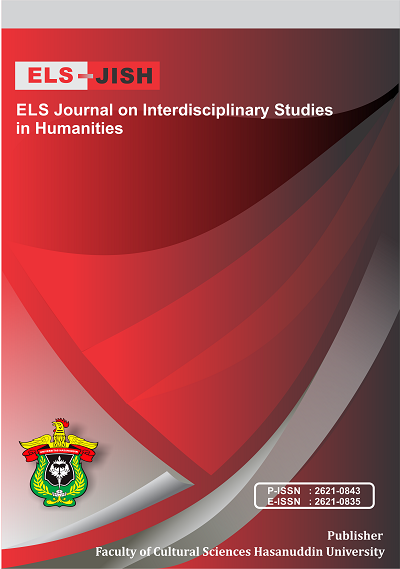Students’ Perceptions of The Use Of Total Physical Response (TPR) Method in Teaching Vocabulary in British English School Makassar
DOI:
https://doi.org/10.34050/elsjish.v7i1.32801Keywords:
Students’ perceptions, Total Physical Response (TPR) Method, VocabularyAbstract
The Total Physical Response (TPR) method is a teaching strategy that helps children learn the names of body parts through movement and rhythm.The purpose of this study is to find out the students’ perceptions of the Total Physical Response (TPR) method of teaching vocabulary at British English School Makassar. The sample for the study included 28 junior students from British English School Makassar. A quantitative study design was employed to collect data relating to the perceptions of the pupils. The questionnaire functioned as the research instrument to help achieve the study’s objectives. The questionnaire was created using the questionnaire that Lin, Chan, and Hasio (2011) used to assess how EFL students felt about learning vocabulary in a computer-supported collaborative environment. A descriptive statistic was employed to analyze the data obtained from the surveys. There were two steps to the data analysis technique. First, the researcher assessed the students’ perceptions using a Likert scale. Second, converted the perception data from the students into a percentage analysis. Subsequently, the researcher employed the students’ statement category to interpret the students’ perspectives. The results verify that 23 or 82.14% of students gave very positive responses, and 5 or 17.86% of students gave positive responses. It revealed that using the Total Physical Response (TPR) method has helped pupils learn language more effectively because the positive environment in the classroom allowed students to enjoy the learning process.
References
Anggawirya, A. M., Prihandoko, L. A., & Rahman, F. (2021, December). Teacher’s Role on Teaching English during Pandemic in a Blended Classroom. In International Joined Conference on Social Science (ICSS 2021) (pp. 458-463). Atlantis Press.
Asher, J. (1968). Total Physical Response Method for Second Language Learning. San Jose: San Jose State Collage.
Baron, R. A. (1995). Physicology. USA: Simon and Schuster company.
Brügger, A., Demski, C., & Capstick, S. (2021). How personal experience affects perception of and decisions related to climate change: A psychological view. Weather, climate, and society, 13(3), 397-408.
Cameron, L. (2001). Teaching Languages to Young Learners. Cambridge: Cambridge University Press.
Freeman & Larsen. (2000). Techniques and principles in language Learning. NewYork: Oxford University Press.
Harmer, J. (2001). The practice of English Language Teaching. New York: Longman: Pearson Education.
Hasnia, H., Andini, C., Tahir, M. D., Hunaeni, H., Zulfikariandi, Z., & Muslimin, M. T. (2022). The Ability of 1st Class Students of SMAN 11 Enrekang to Arrange Verbal and Nominal Sentences. ELS Journal on Interdisciplinary Studies in Humanities, 5(3), 539-550.
Hatch, E., & Brown, C. (1995). Vocabulary, semantics, and language education. Cambridge University Press, 40 West 20th Street, New York, NY 10011-4211 (hardback: ISBN-0-521-47409-4; paperback: ISBN-0-521-47942-8).
Ibrohim. A. T., Septianti, A., & Sadikin, I. S. (2018). Students’ Perception Toward Teaching English Vocabulary Through Total Physical Response (TPR) Method. Professional Journal of English Education, 1(2), 145-156.
Ilmi, P. A.D., & Anwar, K. (2022). Students’ Perception of Total Physical Response Method in Teaching English Vocabulary at Ban Nonsawan School, Thailand. JOLLT Journal of Languages and Language, 10(2), 266-275. DOI: https://doi.org/10.33394/jollt.v%vi%i.4989
Inciman Celik, T., Cay, T., & Kanadli, S. (2021). The Effect of Total Physical Response Method on Vocabulary Learning/Teaching: A Mixed Research Synthesis. English Language Teaching, 14(12), 154-170.
Junaidi, J., Budianto Hamuddin, B., Wendy, S., Fathu, R., & Tatum, D. (2020). ICT usage in teaching English in Pekanbaru: Exploring junior high school teachers’ problems. International Journal of Advanced Science and Technology, 29(03), 5052-5063.
McMillan, J. (2001). Research in Education A Conceptual Introduction. Wesley Longman.
Rahman, F. (2016). The Strategy of Teaching Literature through Language-based Methods: A Communicative Approach. In Annual Seminar on English Language Studies (Vol. 1, pp. 156-170).
Richard, J., & Rodgers, T. (2001). Approaches and Methods in Language Teaching (1st edition). Cambridge: Cambridge University Press.
Samad, I. S., & Nurazikin, N. (2022). Implementation of Body-Movement Method in Teaching Basic Vocabulary at University Muhammadiyah of Enrekang. Majesty Journal, 4(2), 1-5.
Sherf, E. N., Parke, M. R., & Isaakyan, S. (2021). Distinguishing voice and silence at work: Unique relationships with perceived impact, psychological safety, and burnout. Academy of Management Journal, 64(1), 114-148.
Sumarni, B., Bhatta, D. D., & Kho, S. F. C. (2022). The Use of Total Physical Response in Teaching Vocabulary Integrated with Meaningful Classroom Interaction. Journal of Language and Literature Studies, 2(1), 23-32.
Suryana, L. I. (2004). Psikologi Umum II. (sensasi dan persepsi). Bandung: Universitas Islam Bandung. Fakultas Psikologi.
Widodo, H. P. (2005). Teaching Children Using a Total Physical Response (TPR) Method: Rethinking. Bahasa dan Seni, 33(2), 235-238.
Downloads
Published
Issue
Section
License
Copyright (c) 2024 Bunga Tunru, Abidin Pammu, Nasmilah Nasmilah

This work is licensed under a Creative Commons Attribution-ShareAlike 4.0 International License.






